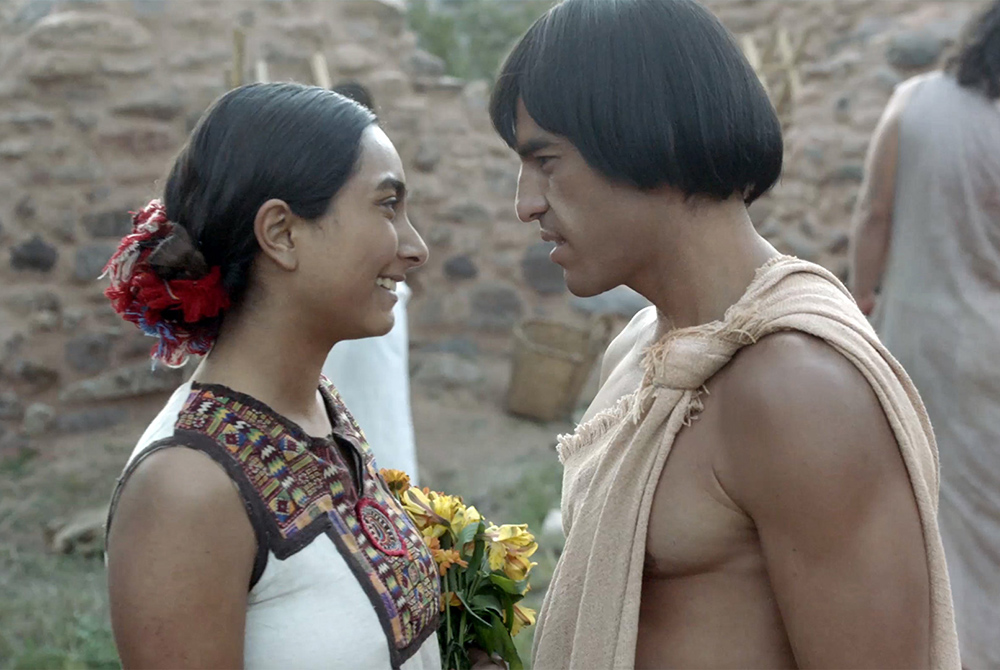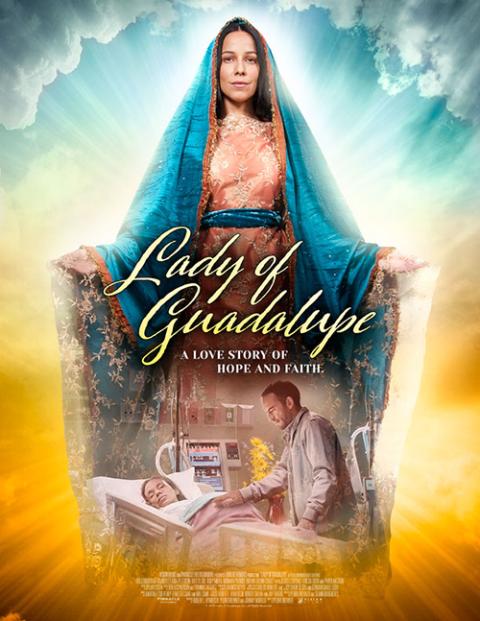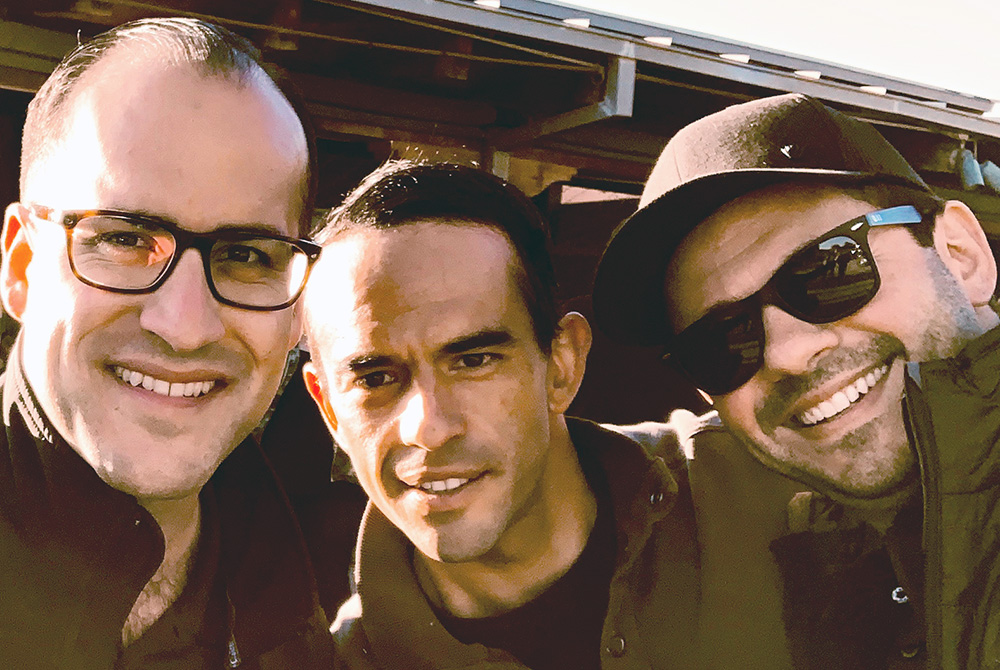
Huitzil Sol as Maria and Guillermo Iván as Juan Diego, in a still from the film "Lady of Guadalupe" (Courtesy of Vision Films, Inc.)
John Martinez (Guillermo Iván) is doing research for a story at the library when he meets the librarian, Mary (Kimberly Aria Peterson). They are immediately attracted to one another. Although they do not have much money they soon marry. Now, however, his editor, Mr. Dominguez (Rudy Miera) asks him to write about something of interest to their New Mexico readers: Mexican culture, faith and identity. The faith aspect makes John uncomfortable as he is not much of a believer.
Dominguez tells John that a Fr. Xavier Escalada (Glenn Craley) is giving a class about Our Lady of Guadalupe and urges him to go and listen to what the priest has to say. The older man thinks that this may be a way for John to work through his discomfort with the topic. Mary is pregnant and prepares for her baby shower that evening. Since the couple only has one car, she drops John off at the lecture venue on the way. Then something happens that night that changes the life of the couple forever.
Flash back about 500 years to December 1531.
Juan Diego Cuauhtlatoatzin (Guillermo Iván), an indigenous Chichimec peasant, lives with his wife Maria (Huitzil Sol) and uncle, Bernardino (Norman Patrick Brown), in a village near what is now Mexico City. Franciscan friars visit the village to teach about Jesus and the Gospels and the people are baptized. The villagers also struggle with the oppressive Spanish conquistadores who mock and beat them. When Bernardino becomes ill, Juan Diego crosses Tepeyac Hill to obtain medicine for him.

Poster for "Lady of Guadalupe" (Courtesy of Vision Films, Inc.)
Hurrying along, Juan Diego is startled by a beautiful woman (Paola Baldión) who appears on the path and speaks to him as a mother to a son. She tells Juan Diego that she would like a chapel built there in her honor so that she can assist the people when they are in need. He must ask Bishop Zumarraga (Herb Hoffman) to build this chapel. Juan Diego feels unworthy and so puts off the lady's request. The next day he takes a different path, but the lady is there just the same, encouraging him. Finally, he gets the courage to approach the bishop who doesn't believe him and asks for a sign from this lady. As we know, the lady is Mary, the Mother of God, and she gives Juan Diego a miraculous sign that is seen by millions of pilgrims a year pre-COVID-19.
"Lady of Guadalupe" ("Nuestra Señora de Guadalupe") is a new film from Los Angeles based executive producer Robert L. Hymers III. Hymers' mother is from Guatemala and though his parents were raised Catholic, "life events led them away from the church," Hymers told me in a recent interview.
His father is an ordained Baptist minister and the founding pastor of the Baptist Tabernacle in Los Angeles, known for his strong conservative views.
Though Hymers was raised Protestant, he believes that Our Lady of Guadalupe "transcends different religious beliefs because she is an icon of feminism, of what it means to be a Latino. She helps with healing people and is a gateway to Christianity, 500 years ago and today.
"The image itself reflects those Mesoamerican societies that were matriarchal, where the female is the leader and the glue of society. Producing this film was a way to underscore the important role of women in Latinx culture. A lot of Christianity is subsumed in the image and Christianity goes deep into the DNA of Mexicans and Central Americans. For me, this is the very meaning of the film."
Hymers, who largely financed the film, said they did not cut corners on the authenticity of settings and music. "We shot the historical scenes in ancient ruins in New Mexico. The music, which was lost for hundreds of years and found not long ago under a church, is authentic as are the instruments that play it." The final scenes of the film were shot at the Basilica of our Lady of Guadalupe in Mexico City.

From left: executive producer Robert L. Hymers III, actor Guillermo Iván and director and co-writer Pedro Brenner appear in a production still from the film. (Courtesy of Vision Films, Inc.)
A friend of mine, an expert on colonial Mexican history, commented, "I saw something in this film that I've not seen in any other film covering the early years of the Spanish Conquest. It is a faithful rendering of the population demographics of the Valley of Mexico. The African component in these years is usually ignored, but 'Lady of Guadalupe' was accurate in its depiction in accordance with current historical understanding."
He added: "Also, I noticed what is probably a reference to a mestizo [a biracial child of European and Native American parentage] during one of the first times we see Juan Diego. There is a boy of about 10 years old whom Juan Diego acknowledges. Whereas the others have straight hair and more Indigenous features, this boy's hair is curly, and he looks mestizo. I think the director was trying to nudge the viewer to understand that this was one of the new human blends that had come about since the Spanish arrived in Mexico."
When I asked Hymers about these insights, he agreed, responding via email, "Yes, your friend's analysis is correct. We didn't think it would be recognized since it's a small detail, but it's an example of the extra pain we went through to ensure the authenticity and inclusiveness of the film. We wanted all ethnic and cultural groups that were involved at the time of Juan Diego to be depicted accurately in the film."
Hymers chose to make the film to educate and inspire viewers. "The movie cuts across the usual faith-based film and speaks to the heart of Mexican culture. As the world becomes more secular, I believe that going back to our core beliefs helps us to become realigned to our God consciousness, eternity and history," he said.
Advertisement
"The film is a response to secularism and speaks to the fragility of life," he said. "There is a metaphysical dimension to the story as well: What are we doing here on Earth and where are we going?"
Hymers admits it was a challenge to cast the film but admits that Guillermo Iván, who plays both Juan Diego and John, is outstanding. To me, Baldión embraces her role as Our Lady with simplicity and gentle conviction thus avoiding sentimentality. It's never easy to cast an actor in the role of Mary.
The Spanish version of the film aired on Univision in late 2020 and will air periodically on Univision over the next few years.
In a way, "Lady of Guadalupe" is two films blended into one because of the parallel timelines and characters separated by five centuries. This is not a new narrative technique, but I think that director Pedro Brenner and his co-writer Seann Dougherty carry it off well.
This film is an homage to Our Lady of Guadalupe and to St. Juan Diego and their place in the cultures of North and Central America especially. If Mr. Hymers had not told me, I would never have guessed the film was produced by a mostly Protestant team. The film is a testament to when it comes to Our Lady of Guadalupe, regardless of our beliefs, we are all "Guadalupanas."








